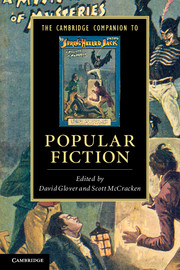Book contents
- Frontmatter
- Introduction
- 1 Publishing, history, genre
- 2 Fiction, theatre and early cinema
- 3 Television and serial fictions
- 4 The public sphere, popular culture and the true meaning of the zombie apocalypse
- 5 The reader of popular fiction
- 6 Reading time: popular fiction and the everyday
- 7 Gender and sexuality in popular fiction
- 8 Pulp sensations
- 9 Bestselling fiction: machinery, economy, excess
- 10 Comic books and graphic novels
- 11 Popular fiction in the digital age
- Further reading
- Index
- Cambridge Companions to …
10 - Comic books and graphic novels
Published online by Cambridge University Press: 28 May 2012
- Frontmatter
- Introduction
- 1 Publishing, history, genre
- 2 Fiction, theatre and early cinema
- 3 Television and serial fictions
- 4 The public sphere, popular culture and the true meaning of the zombie apocalypse
- 5 The reader of popular fiction
- 6 Reading time: popular fiction and the everyday
- 7 Gender and sexuality in popular fiction
- 8 Pulp sensations
- 9 Bestselling fiction: machinery, economy, excess
- 10 Comic books and graphic novels
- 11 Popular fiction in the digital age
- Further reading
- Index
- Cambridge Companions to …
Summary
The first thing to say about comics – plural in form, used with a singular verb – is that it is a medium, not a genre. While comics has often been understood to be a lowbrow genre it is increasingly recognised as a powerful form of expression and communication in its own right, fashioning words and images, and, crucially, panels and ‘gutters’, on the printed page. In technical terms, panels are the framed moments in which a comics story unfolds, and they are separated by the blank space of the gutter, a space that allows the reader to project causality between frames. As for any medium, such as film, it is now standard to treat comics as singular. And, like other media, comics has given rise to a variety of different formats – including comic strips, comic books and graphic novels – and also a profusion of genres, from superhero and war stories to teen romances. However, while there is a booming commercial (i.e. genre-based) comics market, today the form is remarkably unconstrained by genre expectations. Comics narratives exist in spaces both esoteric, as in the recent growth of the abstract comics movement, and wholly public, such as Alan Moore and Dave Gibbons's Watchmen, and Frank Miller's Sin City, both recently popularised by Hollywood film adaptations.
- Type
- Chapter
- Information
- The Cambridge Companion to Popular Fiction , pp. 175 - 195Publisher: Cambridge University PressPrint publication year: 2012
- 9
- Cited by

